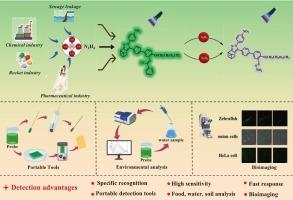一种新型联苯四氢茚唑型联氨检测荧光探针及其在食品检测、环境分析和生物成像中的应用
IF 4.6
2区 化学
Q1 SPECTROSCOPY
Spectrochimica Acta Part A: Molecular and Biomolecular Spectroscopy
Pub Date : 2025-09-19
DOI:10.1016/j.saa.2025.126966
引用次数: 0
摘要
肼(N2H4)是广泛应用于医药、农药、军事等领域的重要化工原料之一。然而,由于N2H4的毒性和致癌性,它也对生态系统和人类健康构成严重威胁。因此,监测N2H4水平对环境和生物安全至关重要。本文研制了一种新型的以诺蒎酮为基础的联苯四氢茚唑型荧光探针TOPIB-PAN,用于N2H4的高灵敏度检测。综合评价表明,探针TOPIB-PAN具有超低检出限(74.5 nM)、广泛的pH耐受性(3-11)和卓越的光稳定性(>1800 min)。该探针成功地用于检测各种基质中的N2H4,包括食物、水和土壤环境。此外,探针TOPIB-PAN在活的HeLa细胞、斑马鱼和洋葱表皮细胞中显示出良好的N2H4荧光成像适用性。通过开发使用topib - pan涂层棉签和滤纸的便携式检测工具,扩展了实际应用。本文章由计算机程序翻译,如有差异,请以英文原文为准。

A novel biphenyl tetrahydroindazole-type fluorescent probe for the detection of hydrazine and its applications in food detection, environmental analysis and biological imaging
Hydrazine (N2H4) is one of significant chemicals widely applied in many fields including medicines, pesticides, and military area. Nevertheless, N2H4 also poses serious threats to ecosystems and human health due to its toxicity and carcinogenicity. Consequently, to monitor N2H4 levels is critical for environmental and biological safety. In this paper, a novel nopinone-based biphenyl tetrahydroindazole-type fluorescent probe TOPIB-PAN was developed for highly sensitive detection of N2H4. Comprehensive evaluation revealed that probe TOPIB-PAN exhibited exceptional performance including an ultra-low detection limit (74.5 nM), broad pH tolerance (3–11), and remarkable photostability (>1800 min). This probe was successfully applied to detect N2H4 in various matrices including food, water, and soil environments. Furthermore, probe TOPIB-PAN showed excellent applicability for fluorescence imaging of N2H4 in live HeLa cells, zebrafish, and onion epidermal cells. Practical applications were extended through the development of portable detection tools utilizing TOPIB-PAN-coated swabs and filter papers.
求助全文
通过发布文献求助,成功后即可免费获取论文全文。
去求助
来源期刊
CiteScore
8.40
自引率
11.40%
发文量
1364
审稿时长
40 days
期刊介绍:
Spectrochimica Acta, Part A: Molecular and Biomolecular Spectroscopy (SAA) is an interdisciplinary journal which spans from basic to applied aspects of optical spectroscopy in chemistry, medicine, biology, and materials science.
The journal publishes original scientific papers that feature high-quality spectroscopic data and analysis. From the broad range of optical spectroscopies, the emphasis is on electronic, vibrational or rotational spectra of molecules, rather than on spectroscopy based on magnetic moments.
Criteria for publication in SAA are novelty, uniqueness, and outstanding quality. Routine applications of spectroscopic techniques and computational methods are not appropriate.
Topics of particular interest of Spectrochimica Acta Part A include, but are not limited to:
Spectroscopy and dynamics of bioanalytical, biomedical, environmental, and atmospheric sciences,
Novel experimental techniques or instrumentation for molecular spectroscopy,
Novel theoretical and computational methods,
Novel applications in photochemistry and photobiology,
Novel interpretational approaches as well as advances in data analysis based on electronic or vibrational spectroscopy.

 求助内容:
求助内容: 应助结果提醒方式:
应助结果提醒方式:


